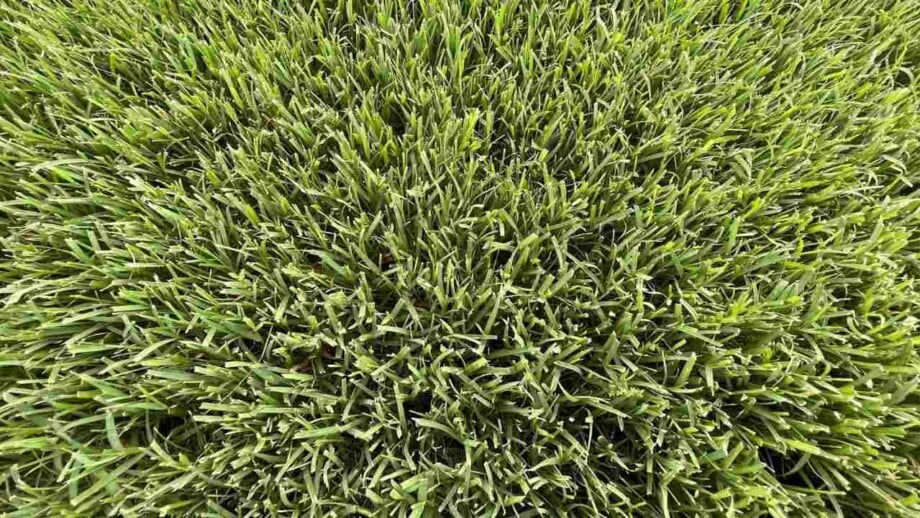Bermudagrass is a durable turfgrass valued for its excellent tolerance to heat and drought conditions and capacity to tolerate heavy use and recuperate quickly.
These qualities lead many homeowners to rely on this grass for its resilience.
But Bermuda grass’ climate requirements limit its widespread use. Depending on your use and region, bermudagrass may be a good choice for you.
Learn everything you need to know about Bermuda grass in this guide.
What is Bermuda Grass?

Bermuda grass is a turf grass variety commonly found in warm climates. While not native to Bermuda, it has an aggressive growth and can grow invasively, similar to crabgrass. This grass’s ability to grow, combined with its excellent drought tolerance and easy care requirements, makes it well-suited turf grass in warm locations in the United States.
This popular grass is favored in places that expect significant foot traffic, making it an excellent grass choice for pets, kids playing, or areas commonly used for thoroughfares or gatherings.
Being a sports turf, its selection for golf courses and athletic fields is a testament to its durability, leaving no doubt that it can handle anything thrown at it.
Botanical Name: Cynodon dactylon
Common Name: Bermuda grass
Family: Poaceae
Shade tolerance: Intolerant, needs at least seven hours of direct sunlight
Hardiness Zones: 7-10 (USDA)
Soil Type: Well-draining clays
Soil pH: Adaptable
Height: 4-12 in. tall
Foot traffic: Tolerant
Spread: Seed, rhizome, stolon
Bermuda Grass Basics
This grass is native to tropical and subtropical countries around the world.
Its arrival in the United States is still being determined. However, historical documents reveal it was already established as one of the primary grasses in 1807 in southern states.
Bermudagrass is a perennial warm-season grass; this means that it comes back yearly in a proper climate and grows actively from late spring to summer.
Bermuda lawn is more sensitive to cold temperatures than Zoysia grass (warm season) or cool season grasses like turf-type tall fescue.
This grass’ lack of cold tolerance limits its use in the north of the grass-growing region that lawn pros called the “transition zone.”
South of this region, from the Atlantic to southern California states, the bermudagrass is a leading lawn choice.
Bermuda grass flourishes in areas with full direct sun and proper drainage. Unlike the Centipede grass, the bermudagrass has better humidity, heat, and salt tolerance and is also drought tolerant.
Though most of Bermuda’s roots stay within six inches of the surface, they can reach over six feet or more in-depth. This extensive root system offers more resilience against environmental stresses than other warm-season lawn grasses.
Bermuda Grass Care

The Bermuda grass care requirements are pretty simple, especially if you give the turf enough attention yearly. By mowing, watering, aerating, and fertilizing your Bermuda grass as needed, you can have the healthiest and most vibrant lawn on your block!
Mowing
This grass grows quickly, requiring frequent mowing, especially in rainy seasons.
Follow these simple tips to keep your Bermuda grass weed free and healthy.
- Ensure your mowers have sharp blades.
- Mow every 10-15 days as needed.
- Remove clippings when mowing.
- Keep grass blades between ½ inch to 2 inches long.
- Your first mow should be in early spring mid-march, after the final frost, once soil temperatures reach at least 55°F.
- Continue to mow throughout spring and fall until the grass enters dormancy or until the first frost.
Watering
Bermudagrass lawns do not need as much watering as other lawn types but still benefit from watering.
- Water in the mornings.
- In spring (March-May) and fall (Sept – Nov), this grass should only be watered if the grass is curling and wilting or if there are unexpected hot, dry periods.
- In summer, water is at least 1.25 inches of water weekly.
- Once established, your Bermuda grass should receive 1 inch of water in weekly irrigation, including rainfall.
Aerating

Bermuda grass should be aerated at least once a year in late spring or early summer to prevent the yard from drying up and to keep it lush.
Compacted soil caused by heavy foot traffic, clay, and silt can compress your lawn, preventing water, air, and nutrients from reaching the turf’s roots. This can result in weeds, constricted growth, and pest problems.
Aerating during peak growth periods helps to break up compacted soil, giving the roots plenty of nutrients.
Sodding

Spring is the best time to plant this grass after the year’s final frost (mid march).
If you’re starting with a new lawn, you should add sod. Allow one entire warm season (spring-fall) for the sod to establish roots before aerating.
Fertilizing

Fertilizing is the easiest way to give your Bermuda grass the nutrients it may lack.
Fertilizer will help the lawn grow fully and combat diseases and weeds.
- Have your soil tested.
- The soil test results will display the nutrients it lacks and which fertilizer to use.
- Fertilize your grass at least twice yearly based on your soil analysis results.
- Bermuda grass lawns often lack nitrogen, so your applications will probably be nitrogen-heavy. The amount of nitrogen will vary based on your location and soil analysis results.
Disease and Weed Control
Like any turfgrass, Bermuda grass is susceptible to certain weeds and diseases that may develop in warm-season grasses.
Proper lawn maintenance, like fertilizing and aerating, can help your grass resist weeds and lawn diseases.
Disease control
Lawn diseases can quickly damage lawns due to the fast spread of fungus and bacteria.
Fungal infections such as large patch fungus, spring dead spot, and dollar spot can be found in bermudagrass lawns, especially if they’re not adequately drained or aerated.
Weed control herbicides and fungicides can treat and prevent lawn diseases.
Weed Control
The are many weeds that can grow in this grass. Depending on where you live and which weeds are prevalent, you may see annual bluegrass, nutsedge, crabgrass, spurge, or clover in your lawn.
The easiest way to control weeds is to prevent them from growing. Apply 1-2 pre-emergent herbicide applications during spring and 1-2 in fall to help your grass fight off invading weeds.
If you missed the pre-emergent application, a Bermuda grass post-emergent herbicide could help.
Insects
Compared to other southern lawns and regions, Bermuda grass is relatively pest free but not immune.
Here are some of the common insects you may encounter:
- Fall Armyworms: these worms are moth larvae. They plague numerous crops but prefer turfgrasses like Bermuda. They feed on leaf blades and cause havoc on your lawn. The key to defeating these insects is to spot them early.
- Dollar spot: this disease is caused by fungi. They create small white/beige circles that eventually form large patches. Improper irrigation and a lack of nitrogen make dollar spot more severe. To treat your Bermuda grass, you must achieve proper nitrogen levels, irrigate your yard in the morning and mow at the right height.

Other Lawn Guides from Planet Natural:
Complete Guide to the Best Robot Lawn Mowers in 2023











